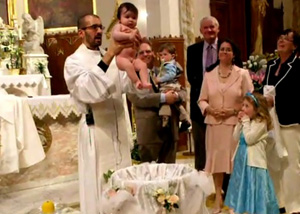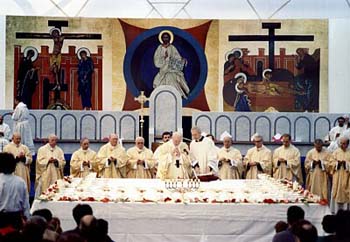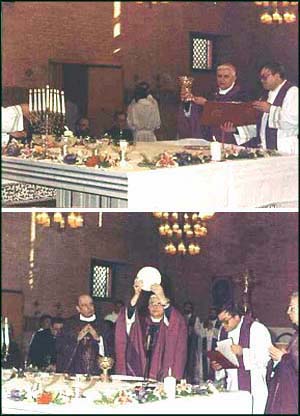 |
Consequences of Vatican II
Benedict’s Contradictions &
The Neocatechumenal Way
Dr. Carol Byrne
In January of this year 2012, Pope Benedict XVI gave another hefty turn of the ratchet of liturgical reform when he approved of the Neocatechumenal Way, calling the organization “a special gift which the Holy Spirit has given to our times” and “a Christian testimony capable of also assuming signs of radicality.” (1)
Here we have a Pope openly allowing a radical revolution in the celebration of religious ceremonies, thus making himself an accessory to desacralization and liturgical mayhem. For Neocat ceremonies are characterized by highly individualistic experimentation involving hugging, kissing, hand holding, personal “testimonies,” raucous singing to the accompaniment of guitars even during the Consecration, dancing around the table which holds a Jewish Chanukkiah while fragments of an outsize “pancake” Host are served to seated communicants who pass the chalice from hand to hand.

In this baptism water never touches the baby's forehead, as required by the Sacrament |
Even though Benedict XVI issued a mild warning that the Way’s liturgies should conform to the “liturgical norms” approved by the Holy See, he rubber-stamped an enormous portion of the Neocatechumenal “liturgy.” It continues unabated, as in this Neo-Catechumenal “baptism,” whose validity can be disputed since the water did not touch the baby’s head.
Besides, so much latitude has been granted for liturgical experimentation throughout the Church as to weaken the force of any admonition. As the old joke has it, what was once prohibited first becomes ignored, then tolerated, later approved and finally mandated. The Pope’s approval sounds as if he had forgotten that the Church’s liturgy is the solemn and reverential worship of God.
Is this the 'hermeneutic of continuity'?
What more explicit evidence is there of a split between the pre-conciliar Church and the post-conciliar Church than a radical revolution in the outward forms of public worship? It is generally accepted that no religion with an ancient system of worship can alter it without producing a serious dislocation in the faith of its followers. It follows that the sacred rituals of the Catholic Church cannot be substantially reformed – as per the Paul VI’s Novus Ordo – without a widespread spiritual crisis among the faithful resulting in a drastic secularization or Protestantization of Catholic belief.
And once official changes have been mandated in the liturgy, this is taken by many people as a signal for general revolution in doctrinal, moral as well as liturgical matters. So, I believe that the deepest and most urgent issue for the Church today should be to evaluate the extent to which the conciliar Popes themselves have contributed to the general radicalization and apostasy we see around us.

John Paul II concelebrating Mass in the Neocat style |
Of course, the Pope is well aware that the Neocats do not want the traditional forms of worship and sacramental practice; notwithstanding he is encouraging this “ecclesial movement” to continue – which is a way of officializing their highly disrespectful liturgical ceremonies.
Pope Benedict had always admired the Neocatechumenal Way from the moment he got to know it. This is what he said in a lecture delivered at the Vatican-sponsored World Congress of the Ecclesial Movements in May 1998:
"For me personally it was a wonderful experience when, in the early 1970s, I first came into closer contact with movements such as the Neocatechumenal Way, Communion & Liberation and the Focolare Movement." (2)
It is disturbing to note that the then Cardinal Ratzinger, who was soon to become Prefect for the Congregation of the Doctrine of the Faith, displayed no concern for the degree of fidelity of these movements to the traditional Catholic Faith. Instead, he was dazzled by “the energy and enthusiasm with which they lived their faith and the joy of their faith, which impelled them to share with others the gift they had received.”
In other words, emotional experience is paramount in the lives of believers. But these exuberant religious feelings can mislead people about the faith, which has to be, first of all, not of the religious sentiments, but of the mind.
We are entitled to ask how someone can have faith based on the outward display of sentiments of “charismatic” communities when St. Pius X in his Encyclical Pascendi quite clearly condemned this modernist presupposition:
"That in the religious sentiment one must recognize a certain intuition of the heart that puts man in immediate contact with the very reality of God and infuses such a persuasion of His existence and action ... that exceeds the strength of any persuasion that the mind is able to reach. They affirm, therefore, a real experience that surpasses all rational experience. … Now, such an experience is what properly and truthfully makes the one who can reach it a believer." (3)
A longstanding approval
This same modernist priority given to the emotions, so evident in the Neocatechumenal Way, is also at the basis of World Youth Days, much loved and promoted by the Conciliar Popes.

Card. Ratzinger saying a Mass in a Neocatechumenal church |
In 2009, Benedict XVI wrote to Cardinal Joseph Cordes (formerly of the Pontifical Council of the Laity), who helped launch the first World Youth Day in 1985, praising him for his work among the new lay movements. In his letter the Pope mentioned that the Neocatechumenal Way, together with other lay organizations, was imbued with “the power of the Holy Spirit that gives new paths and in unpredictable ways keeps the Church young.” (4)
There was nothing authentically new in the Pope’s words. In fact, he was using the same hackneyed phrases borrowed from his predecessors which, it could be said, had already exhausted the lexicon of clichés.
The plot thickens as we find that the inspirer of the conciliar Popes was none other than Archbishop Annibale Bugnini who, as the Secretary for the Congregation of Divine Worship, had collaborated with the founders of the Neocatechumenal Way in launching the movement and choosing its name. (5)
In 1972, Bugnini published in Notitiae, the official journal of that Congregation, a note of praise for the Neocatechumenal Way as a “gift of the Holy Spirit” exemplifying the vision of Vatican II. (6) He praised the Neocatechumenate for being a “seriously committed group” and for its “merit” in “the formation of true Christians” through the catechumenate. (7)
In 1974, Paul VI, repeated this theme, using virtually the same words of praise in his address to the NCW members gathered in Rome. (8)
In 1980, John Paul II praised the Neocatechumenal Way for its commitment “towards a healthy radicalization of our Christianity, of our faith, towards an authentic evangelical radicalism.” (9)
If this is what is meant by Pope Benedict’s “hermeneutic of continuity,” it looks quite inconsistent and suspicious, since this Bugnini-inspired movement has little in common with the previous Catholic movements before the Council. It only has to do with the Protestant religiosity, from which NCW copied many of its liturgical characteristics.
Vatican’s contradictory identikit
Is this what the Church has come down to since Vatican II? Benedict XVI cannot be exonerated from his own responsibility in the crisis. He is the same Ratzinger who was talking about razing the bastions of the Church. (10)
He is the same Ratzinger who, with his mentor Karl Rahner, sabotaged Mariology at Vatican II.
He is the same Ratzinger who affirmed that the papal teachings against Modernism are obsolete, although when he was Prefect of the Congregation for the Doctrine of the Faith, he was regarded by many Catholics as a model of conservatism.
Since he became Pope, he has played a crucial role in trying to save Vatican II from a growing rejection by giving it a “conservative” look, although he never stopped promoting the lethal shibboleths of religious liberty, ecumenism and collegiality that are still poisoning the Church.
It was Benedict who at the same time approved the (provisory) return to the Tridentine Mass and encouraged the Neocatechumenals to go merrily on their new liturgical Way.
Therefore, the identity of Benedict XVI is found in the clash of many contradictions.

The movement enters San Diego, California: dancing around the table, left, and playing guitars, center; large round loaves of bread are baked specially for the "hosts", right. |
1. Zenit, January 20, 2012
2. Joseph Ratzinger, ‘The Ecclesial Movements: A Theological Reflection on Their Place in the Church’, in Pontifical Council for the Laity, Movements in the Church, Vatican City, 1999, pp. 46-7. This article also appeared as ‘The Theological Locus of Ecclesial Movements’ in Communio, vol. 25, 1998, pp. 480-504.
3. St. Pius X. Pascendi Dominici gregis, n. 14.
4. http://www.phillyspirit.com/index.cfm?load=page&page=152
5. Kiko Arguello, Carmen Fernandez, Fr Mario Pezzi, Statute of the Neocatechumenal Way, Hope Publishing House, 2003, p. 108
6. Notitiae, July-August 1974
7. A. Bugnini, La Riforma Liturgica, p. 579, n. 26
8. Paul VI, General Audience, 5th August 1974 in Notitiae, July-August 1974, p. 230
9. L’Osservatore Romano, 3-4 November 1980
10. Cardinal Ratzinger, Principles of Catholic Theology, p. 391 where he cites Urs von Balthasar who declared that the Church “must demolish longstanding bastions.” In Animus Delendi I and II– “The Desire to Destroy.” Atila Guimarães shows the devastating results of the “demolition of bastions” in the life of the Church.

Posted April 30, 2012

Related Topics of Interest
 Pope: Neocats Are a ‘Special Gift of the Holy Spirit’ Pope: Neocats Are a ‘Special Gift of the Holy Spirit’
 The Spirit of Madonna House The Spirit of Madonna House
 Liturgical Peace or Liturgical Apartheid? Liturgical Peace or Liturgical Apartheid?
 Proletarian Tendencies in the Modern Catholic Church Proletarian Tendencies in the Modern Catholic Church
 The Panreligion of Chiara Lubich The Panreligion of Chiara Lubich
 Focolare President Favoring Buddhism Focolare President Favoring Buddhism
 Card. Von Balthasar: Ratzinger Did Not Change Card. Von Balthasar: Ratzinger Did Not Change
 The ‘Poor Pope Benedict’ Syndrome The ‘Poor Pope Benedict’ Syndrome



|
Vatican II | Hot Topics | Home | Books | CDs | Search | Contact Us | Donate

© 2002-
Tradition in Action, Inc. All Rights Reserved
|
 |
|